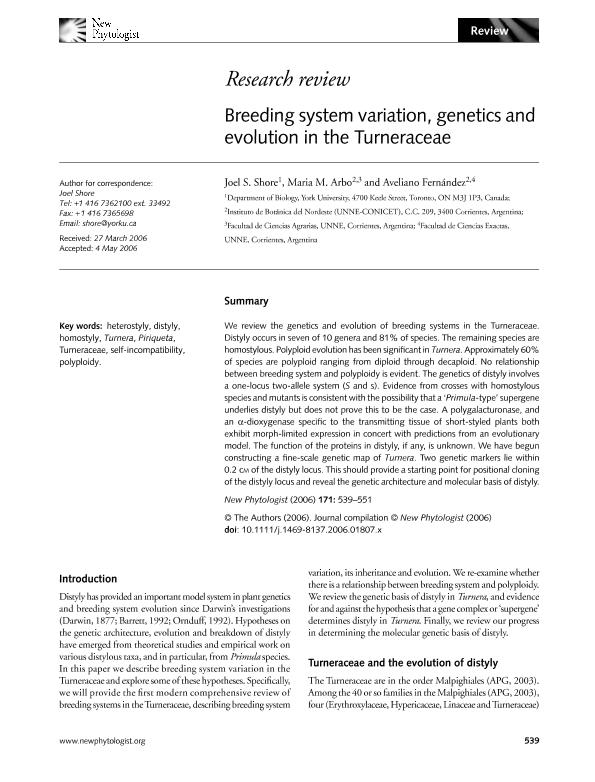Mostrar el registro sencillo del ítem
dc.contributor.author
Shore, Joel S.
dc.contributor.author
Arbo, Maria Mercedes

dc.contributor.author
Fernandez, Aveliano

dc.date.available
2018-04-11T21:15:40Z
dc.date.issued
2006-12
dc.identifier.citation
Shore, Joel S.; Arbo, Maria Mercedes; Fernandez, Aveliano; Breeding system variation, genetics and evolution in the Turneraceae; Wiley Blackwell Publishing, Inc; New Phytologist; 171; 3; 12-2006; 539-551
dc.identifier.issn
0028-646X
dc.identifier.uri
http://hdl.handle.net/11336/41821
dc.description.abstract
We review the genetics and evolution of breeding systems in the Turneraceae. Distyly occurs in seven of 10 genera and 81% of species. The remaining species are homostylous. Polyploid evolution has been significant in Turnera. Approximately 60% of species are polyploid ranging from diploid through decaploid. No relationship between breeding system and polyploidy is evident. The genetics of distyly involves a one‐locus two‐allele system (S and s). Evidence from crosses with homostylous species and mutants is consistent with the possibility that a ‘Primula‐type’ supergene underlies distyly but does not prove this to be the case. A polygalacturonase, and an α‐dioxygenase specific to the transmitting tissue of short‐styled plants both exhibit morph‐limited expression in concert with predictions from an evolutionary model. The function of the proteins in distyly, if any, is unknown. We have begun constructing a fine‐scale genetic map of Turnera. Two genetic markers lie within 0.2 cm of the distyly locus. This should provide a starting point for positional cloning of the distyly locus and reveal the genetic architecture and molecular basis of distyly.
dc.format
application/pdf
dc.language.iso
eng
dc.publisher
Wiley Blackwell Publishing, Inc

dc.rights
info:eu-repo/semantics/openAccess
dc.rights.uri
https://creativecommons.org/licenses/by-nc-sa/2.5/ar/
dc.subject
Heterostyly
dc.subject
Distyly
dc.subject
Homostyly
dc.subject
Turnera
dc.subject
Piriqueta
dc.subject
Turneraceae
dc.subject
Self-Incompatibility
dc.subject
Polyploidy
dc.subject.classification
Otras Ciencias Biológicas

dc.subject.classification
Ciencias Biológicas

dc.subject.classification
CIENCIAS NATURALES Y EXACTAS

dc.title
Breeding system variation, genetics and evolution in the Turneraceae
dc.type
info:eu-repo/semantics/article
dc.type
info:ar-repo/semantics/artículo
dc.type
info:eu-repo/semantics/publishedVersion
dc.date.updated
2018-03-21T15:29:27Z
dc.identifier.eissn
1469-8137
dc.journal.volume
171
dc.journal.number
3
dc.journal.pagination
539-551
dc.journal.pais
Reino Unido

dc.journal.ciudad
Londres
dc.description.fil
Fil: Shore, Joel S.. York University, Toronto; Canadá
dc.description.fil
Fil: Arbo, Maria Mercedes. Consejo Nacional de Investigaciones Científicas y Técnicas. Centro Científico Tecnológico Conicet - Nordeste. Instituto de Botánica del Nordeste. Universidad Nacional del Nordeste. Facultad de Ciencias Agrarias. Instituto de Botánica del Nordeste; Argentina
dc.description.fil
Fil: Fernandez, Aveliano. Consejo Nacional de Investigaciones Científicas y Técnicas. Centro Científico Tecnológico Conicet - Nordeste. Instituto de Botánica del Nordeste. Universidad Nacional del Nordeste. Facultad de Ciencias Agrarias. Instituto de Botánica del Nordeste; Argentina
dc.journal.title
New Phytologist

dc.relation.alternativeid
info:eu-repo/semantics/altIdentifier/doi/http://dx.doi.org/10.1111/j.1469-8137.2006.01807.x
dc.relation.alternativeid
info:eu-repo/semantics/altIdentifier/url/https://nph.onlinelibrary.wiley.com/doi/abs/10.1111/j.1469-8137.2006.01807.x
Archivos asociados
